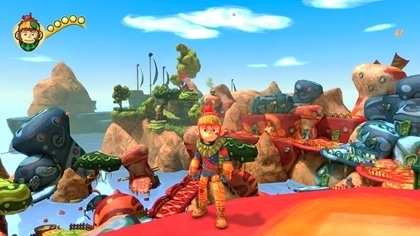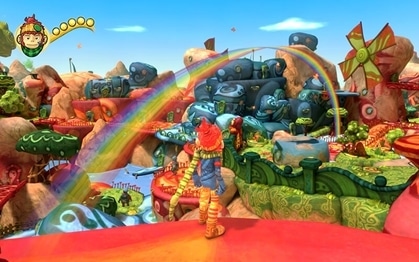This review was originally written for Gamin' Girl.The Last Tinker: City of Colors is Mimimi Productions’ first venture onto PCs after several forays onto iOS. The platformer has a childish and colourful appearance that evokes memories of 90’s era titles where bright was beautiful, but will it justify the comparison to classics like Crash Bandicoot and Banjo Kazooie?Tinkerworld was a world of imagination where anything and everything could be built from the basic materials of colour, paper and glue. Unfortunately, some of the inhabitants had their own favourite colours and they refused to work with those of a different colour. Colortown soon became a divided city. In the outer district of the city, a place still free from conflict, lives Koru. When his friend Tap is injured, in return for healing his friend he is tricked into unleashing a devastating Bleakness into the city where all colour is drained from anything that it touches. As the only person who can fix his mistake, Koru must restore colour and harmony to Colortown before it’s too late.

While the game may look like platformers of years gone by, the gameplay seems to borrow its mechanics from newer titles. Koru’s movement and ability to travel is reminiscent of Assassin’s Creed or Prince of Persia; hold down the sprint button and point him in the right direction to effortlessly parkour along the right path. There is the occasional path that may lead to a collectible or boxes that can be smashed for coloured gems, the currency of the game, but the correct path is often obvious and very little deviation is allowed in most levels. Every now and again, players will need to solve basic puzzles in order to progress, but these are not too challenging.
When you can explore, it is often worth doing so. The city of Colortown is certainly not devoid of life and you actually feel like you want to look around. As an example, in a gallery full of paintings, each picture had a story. The majority of NPCs have something to say. There are also easter eggs that can be found with a little exploration, including a nod to the Metal Gear Solid franchise.
Of course, the Bleakness had to bring along enemies with which to take over Colortown. It is here that the different personality traits of the different colours come into play. Each colour has a different way of damaging the enemy. Red, the colour of anger, deals direct damage to the enemy’s health. Green, the colour of fear, makes enemies run away from you. If used carefully, enemies can be made to run into thorn bushes or off ledges. Blue, the colour of sadness, freezes enemies on the spot and makes them vulnerable to attacks from behind.
The game gradually introduces each of these attacks as you travel through each coloured sector of the city. While facing the general enemies, you can use any attacks to try and defeat them. You will soon identify the larger enemies that need to be taken out first, but this tends to be as challenging as the combat gets. As players progress through the game, the aforementioned coloured gems can be used to purchase upgraded combat moves, something that definitely makes a difference as you head further into the title and meet stronger bosses.

Aside from the combat and platforming, there are a few other sections that seek to liven things up. Sometimes you’ll need to use stealth. Sometimes you’ll need to rely on quick reactions if you’re to make it along high-speed rails without impaling yourself on a thorny bush or a pile of bleakness. Finally, there is the quicktime event that sees you leading an orchestra in an attempt to produce something that sounds more like music than noise. All of these stop the gameplay from becoming stale and help to keep the story moving along.
The Last Tinker: City of Colors is not a short title, with a campaign that will take people eight or nine hours, but the game does not outstay its welcome. You can take the story as a lesson in the importance of working with others, or you can try to find a deeper meaning in the fallacy of racial segregation. Regardless, the game is worth picking up if you’re looking for a relaxing platformer. There is enough here to keep both children and adults amused despite the game’s childish appearance.
3.5